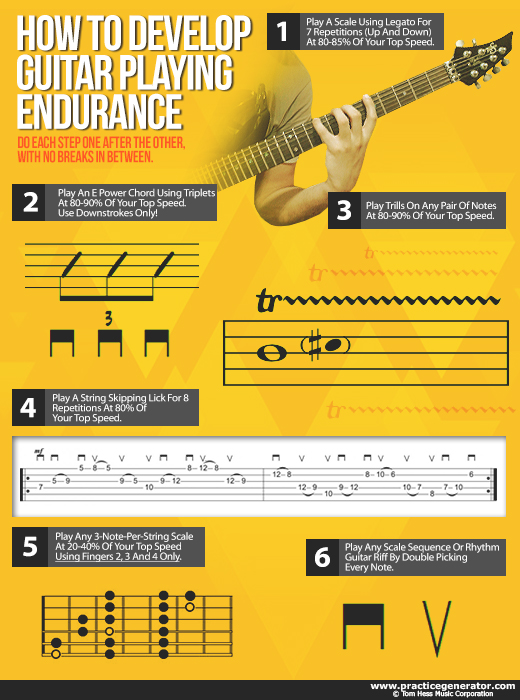Want to enjoy your guitar practice more and make more progress? Use circuit training as a major part of your guitar practicing routine. This type of training use various exercises in a particular way for a pre-determined amount of time.
The following process describes how circuit training improves your guitar practice effectiveness:
1. It uses your time more efficiently. You work on improving various techniques in the time that most guitarists would only work on one. This helps your guitar playing improve at a faster rate.
2. It is enjoyable. Circuit training takes away the redundancy of repeating the same exact exercises over and over again.
3. It strengthens your guitar playing fluency. In order to use the skills you learn in actual music, you need to combine a variety of guitar techniques together. Circuit training is excellent for this.
4. It keeps your mind focused. It is easier to concentrate when you rotate through different exercises. This helps make your guitar practice time much more effective.

Guitar Practice Training Circuit Sample:
Notice: Make sure to warm up your hands extensively before you begin practicing!
Once your hands are completely warmed up and ready, go through these steps:
1. Run through an entire scale for seven repetitions while exclusively using legato technique at EIGHTY percent of your fastest speed. Note: one repetition equals playing through the scale one time both ascending and descending.
After you’ve done this, go right to this next step:
2. Use palm-muting to play an A5 chord with triplet rhythm (three notes per click) for twenty beats at EIGHTY to NINETY percent of your fastest speed. While doing this, only use downstrokes!
After you’ve done this, go right to this next step:
3. Rapidly alternate between hammer ons and pull offs on any two notes at EIGHTY to NINETY percent of your fastest speed. As you do this, use variance in the pair of fingers every 8 beats. Do this until you’ve used every finger combination at least four times.
After you’ve done this, go right to this next step:
4. Play any string skipping lick you can think of for eight repetitions at EIGHTY percent of your fastest speed.
After you’ve done this, go right to this next step:
5. Play any scale of your choice using three notes per string at TWENTY to FORTY percent of your fastest speed while not using your index finger to fret notes (in other words you can only use fingers 2, 3 and 4) for a total of three repetitions.
After you’ve done this, go right to this next step:
6. Play a scale sequence or rhythm guitar riff of your choice while using double picking (picking every note two times) for a total of ten repetitions.
Go through this circuit nonstop for twenty minutes.
Advice For Completing This Guitar Practice Circuit:
-As you play with legato technique, only pick the first note to be played on any given string. Then, use hammer ons/pull offs to play the rest of the notes.
-BEFORE you begin practicing, plan the exact exercise and metronome speeds you will need ahead of time. Avoid pausing between steps to think about which exercise to play next and which tempo you will need to set your metronome to. Have this written down in front of you and ready to go before you start.
-When moving from one exercise/step to the next, reduce the amount of time for setting the metronome tempo to ten seconds max.
-Don’t hesitate after you’ve finished the circuit. Go immediately back to step one and begin again.
-Eliminate extra tension in your body as much as possible. This is key for improving your endurance as you practice. This video helps you avoid excess tension in your guitar playing:
https://www.youtube.com/embed/K4CA-auTUVc
-Never play guitar if you experience pain! While it is normal to experience fatigue (a dull, burning sensation), it is not normal to feel sudden sharp stabs of pain... this is a sign that you need to stop immediately.
Note: you should not completely replace your entire guitar practice schedule with circuit training. Instead, you should use it with other guitar practice strategies so you can make tons of progress in less time.
Use this circuit training approach together with your normal practicing routine twice per week for the next four weeks. Watch as your guitar practice becomes more fun and your skills increase exponentially.
Discover how to create guitar practicing routine the right way.
About The Author:
Tom Hess is a professional touring musician, recording artist and online guitar teacher who teaches guitarists from all over the world in his online guitar lessons. On his website, tomhess.net, you can get additional free tips about guitar playing, guitar playing resources , mini courses and surveys.
Post new comment
Please Register or Login to post new comment.